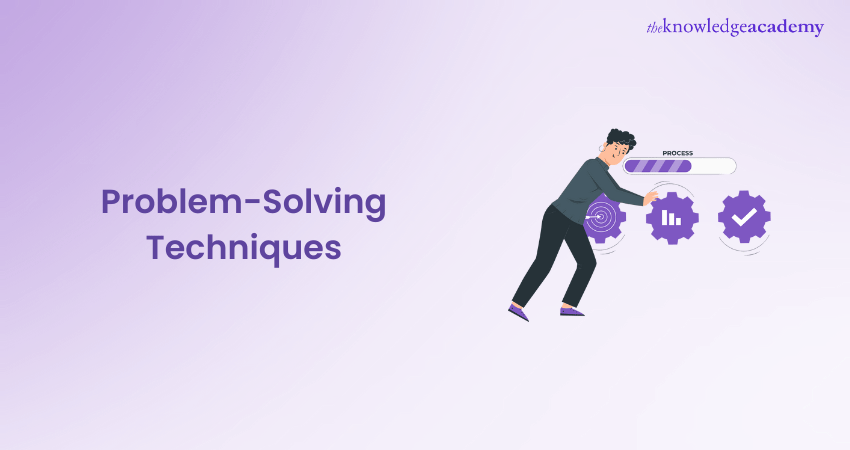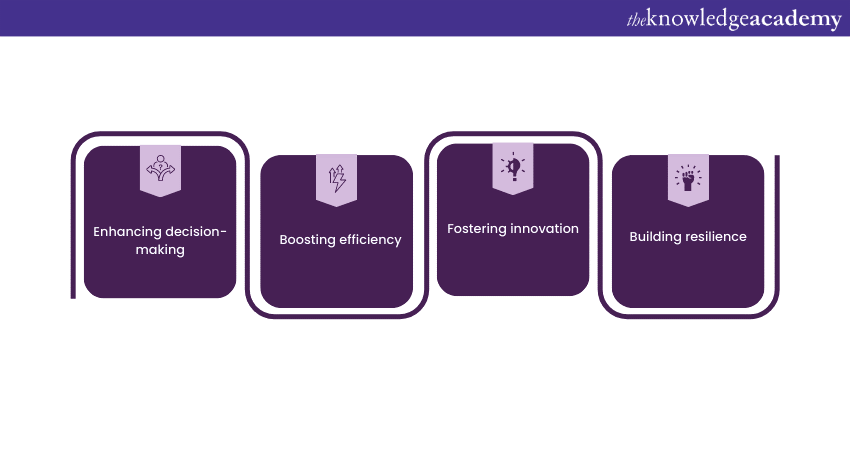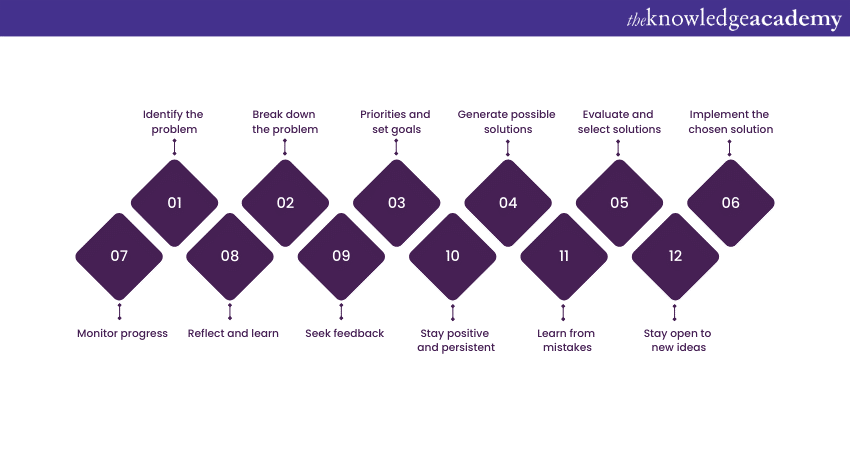We may not have the course you’re looking for. If you enquire or give us a call on +352 8002-6867 and speak to our training experts, we may still be able to help with your training requirements.
Training Outcomes Within Your Budget!
We ensure quality, budget-alignment, and timely delivery by our expert instructors.

Problem-Solving is a critical skill that individuals and organisations must possess. Effective Problem Solving Techniques play a pivotal role in finding optimal solutions for everyday obstacles to complex issues.
According to Indeed, the average salary of a Problem Solver in the UK is £30,000 per year. Further, in this blog, you will learn about the top 15 Problem-Solving Techniques and their importance.
Table of Contents
1) What are Problem-Solving Techniques?
2) The Importance of Problem-Solving Techniques
3) Basic Problem-Solving Techniques
4) Top 20+ Problem-Solving Techniques
5) Conclusion
What are Problem-Solving Techniques?
Before diving into the specific techniques, let's understand what Problem-Solving Techniques entail. Problem-Solving techniques are systematic approaches used to identify, analyse, and solve problems in a structured manner. These techniques empower individuals to address issues efficiently by breaking them down into manageable steps.

The Importance of Problem-Solving Techniques
Problem-Solving Techniques play a pivotal role in both personal and professional aspects of life. Their importance lies in their ability to equip individuals with the necessary skills to overcome challenges and make informed decisions. Let's explore why these techniques are so essential:

1) Enhancing decision-making: Effective Problem-Solving Techniques enhance the decision-making process. When individuals face problems, they are encouraged to explore various solutions and carefully evaluate their potential outcomes.By considering the consequences of each option, individuals can make wise decisions that lead to positive outcomes.
2) Boosting efficiency: In today's fast-paced world, efficiency is paramount.Problem-Solving Techniques enable individuals to address issues promptly and efficiently. By breaking down problems into manageable steps, they can tackle each component with precision, ultimately speeding up the Problem-Solving process.
3) Fostering innovation: Creativity is a driving force behind innovation, and Problem-Solving Techniques stimulate this aspect. When individuals engage in brainstorming sessions and explore unconventional solutions, they open the door to innovative ideas that can revolutionise their approach to Problem-Solving.
4) Building resilience: The ability to bounce back from challenges and setbacks is known as Resilience. Problem-Solving Techniques encourage individuals to view obstacles as opportunities for growth and learning. By approaching issues with a positive mindset, individuals can build resilience and nurture the confidence to tackle any future challenges.
Problem-Solving Techniques are instrumental in empowering individuals to handle various situations effectively. By improving decision-making, boosting efficiency, fostering innovation, and nurturing resilience, these techniques become valuable assets in both personal and professional endeavours.
Unleash your Problem-Solving prowess and conquer challenges with our transformative Problem Solving Training - Sign up now!
Basic Problem-Solving Techniques
Basic Problem-Solving Techniques are essential tools that individuals can employ to address a wide range of challenges effectively. These techniques serve as a foundation for Problem-Solving and can be applied in various situations. Here are some basic Problem-Solving Techniques:

1) Identify the problem: The first step is to clearly identify the issue at hand. Take time to understand the problem's nature, scope, and impact. Gathering relevant information and data is crucial for gaining a comprehensive understanding of the situation.
2) Break down the problem: Therefore, breaking down the problem into smaller, more manageable parts can make it easier. Analyse the problem's components and consider how they relate to one another.
3) Priorities and set goals: Determine which aspects of the problem are most urgent and require immediate attention. Keep Specific, Measurable, Achievable, Relevant, and Time-bound (SMART) goals to guide the Problem-Solving process.
4) Generate possible solutions: Brainstorm potential solutions to the problem. Encourage creative thinking and be open to creative ideas. At this stage, the quantity of ideas is more important than their quality. All ideas are considered without judgment.
5) Evaluate and select solutions: After generating a list of potential solutions, evaluate each one based on its feasibility, practicality, and alignment with the established goals. Consider the pros and cons of each option.
6) Implement the chosen solution: Once the most suitable solution is selected, put it into action. Create a clear action plan outlining the necessary steps, responsibilities, and timelines for implementation.
7) Monitor progress: Consistently track the progress of the implemented solution. Assess its effectiveness and whether it is achieving the desired results. If necessary, make adjustments to optimise the outcome.
8) Reflect and learn: After solving the problem, take some time to reflect on the process. Identify what worked well and what could be improved. Learning from past experiences can help enhance Problem-Solving skills for future challenges.
9) Seek feedback: Gather feedback from relevant stakeholders involved in the Problem-Solving process. Feedback can offer valuable insights and different perspectives, leading to more comprehensive solutions.
10) Stay positive and persistent: Though Problem-Solving can be challenging, maintaining a positive attitude and persistence is essential. Some problems may require multiple attempts and iterations before finding the best solution.
11) Learn from mistakes: Mistakes are a natural part of the Problem-Solving process. Embrace them as learning opportunities and use them to improve future approaches.
12) Be open to new ideas: Problem-Solving is not a linear process. Stay open to new information, ideas, and perspectives that may arise throughout the process.
Individuals can incorporate these basic Problem-Solving Techniques into their approach to become more effective in addressing various challenges and making informed decisions. These techniques provide a structured and systematic way to navigate problems, leading to successful outcomes in both personal and professional contexts.
Transform conflict into collaboration and build harmonious workplaces with our Conflict Management Training – Sign up today!
Top 20+ Problem-Solving Techniques
Problem-Solving Techniques are systematic approaches used to identify, analyse, and resolve issues in a structured and effective manner. These techniques are crucial in both personal and professional spheres as they enable individuals to navigate challenges and find practical solutions. Here are the top 20+ Problem-Solving Techniques:
1) Define the problem clearly
Precisely defining the problem is the cornerstone of effective Problem-Solving. It includes finding the root cause of the issue and understanding its scope. Gathering relevant information and data is crucial at this stage to gain a comprehensive understanding of the problem's context. Articulating the problem in simple terms ensures clarity for all involved in the Problem-Solving process. This will make the communication and collaboration easier.
2) Brainstorming solutions
Once the problem is well-defined, the next step is to conduct brainstorming sessions. These sessions aim to generate a diverse range of potential solutions. It's essential to create a supportive and open environment during brainstorming, encouraging participants to think freely and creatively. Sometimes, unconventional ideas that emerge during brainstorming sessions can lead to creative and unique solutions that may not have been considered otherwise.
3) Evaluating and selecting solutions
With a pool of potential solutions, it's time to evaluate each option critically. Consider factors like feasibility, practicality, cost-effectiveness, and alignment with the overarching goals. A well-thought-out evaluation process enables decision-makers to narrow down the list of potential solutions. This approach identifies those solutions that are most viable and likely to address the problem effectively.
4) Implementing the solution
The selected solution now needs to be put into action. Creating a detailed action plan that defines the specific steps, responsibilities, and timelines is essential. Having a well-structured implementation process ensures that everyone involved understands their role and contributes to the successful execution of the solution.
5) Monitoring and evaluating
Implementing the solution is not the end of the Problem-Solving process. Continuous monitoring and evaluation are critical to assess the effectiveness of the solution. Regularly tracking progress and gathering feedback from stakeholders allow for adjustments and improvements as needed. This iterative method ensures that the solution remains relevant and optimised over time.
6) Root Cause Analysis (RCA)
Rather than merely addressing the symptoms of a problem, an RCA seeks to identify the underlying factors that trigger the issue. By targeting the root cause, individuals can develop sustainable solutions that prevent the problem from recurring in the future.
7) SWOT analysis
A SWOT analysis is a valuable tool that helps individuals understand the internal strengths and weaknesses of their organisation or themselves. It also identifies external opportunities and threats in the environment. By identifying these factors, Problem-solvers can develop well-informed strategies that align with their strengths and capitalise on opportunities. At the same time, they address weaknesses and mitigate threats.
8) Decision matrix analysis
When faced with multiple solutions, a decision matrix analysis allows for a structured comparison. This technique involves assigning weights to different criteria and scoring each solution based on those criteria. The solution with the highest score indicates the most viable option.
9) Creative thinking
Encouraging creative thinking during Problem-Solving opens up a world of possibilities. Techniques like mind mapping, brainstorming, and lateral thinking stimulate great ideas and novel approaches to tackle problems creatively.
10) Collaborative Problem-Solving
Involving a diverse group of individuals in the Problem-Solving process brings in a variety of perspectives and expertise. Collaborative Problem-Solving fosters a sense of ownership among team members, promoting active participation and commitment to finding effective solutions.
11) Risk analysis
Assessing potential risks and challenges associated with each solution helps individuals anticipate and prepare for contingencies. Identifying potential obstacles allows for the implementation of risk mitigation strategies to minimise negative outcomes.
12) Learn from past experiences
Reflecting on past Problem-Solving experiences, both successes and failures, provides valuable insights. Learning from these experiences helps improve Problem-Solving skills and approaches over time, making individuals more adept at addressing future challenges.
13) Consider constraints and resources
In the process of Problem-Solving, it's essential to take into account the constraints and available resources. These constraints may include budget limitations, time constraints, or external factors beyond one's control. By understanding and acknowledging these limitations, Problem Solvers can craft solutions that are realistic and achievable within the given constraints.
14) Feedback and input
Solving problems doesn't need to be an individual effort. Getting advice and opinions from others can offer important perspectives and fresh ideas. Input from colleagues, mentors, or users can enrich your understanding of the issue and open up new solution paths.
15) Continuous learning and adaptability
Problem-Solving is an ongoing process, and learning is a vital part of it. Adopt an approach of continuous learning and adaptability. Stay open to new information, emerging technologies, and best practices inProblem-Solving. Being adaptable allows individuals to adjust their approaches as new challenges arise, ensuring they remain effective Problem Solvers in dynamic environments.
Embrace the art of effective leadership and propel your career forward with our exclusive Management Training – Sign up now!
16) Six thinking hats
Different people solve problems uniquely, influenced by their team, job roles, biases, or internal politics. The Six Thinking Hats method helps them tackle problems from various perspectives, focusing on facts and data, creative solutions, or potential drawbacks. This framework effectively removes roadblocks, enabling teams to address all aspects of complex problems comprehensively.
17) Lightening Decision Jam (LDJ)
The process involves a series of timed exercises that guide participants through identifying issues, generating solutions, deciding on the best solutions to pursue, and creating action steps. The goal of an LDJ is to sidestep the usual debate and analysis paralysis that can occur in team meetings, leading to clear, actionable outcomes in a short amount of time. This method is particularly useful for solving specific problems, improving processes, or breaking through creative blocks.
18) Problem definition process
Complex problems don't always require complex solutions; often, simple approaches are enough to tackle them effectively.
Starting with a clear identification and definition of the problem allows the group to shift their perspective, seeing the problem as an opportunity for change. The process begins with pinpointing a central question and examining its various aspects. Then, the group divides into five teams, each adopting unique approaches like escape, reversal, exaggeration, distortion, or wishful thinking to tackle the issue.
Each team sets a goal related to the problem and brainstorms solutions according to their assigned method, which is later shared with the entire group. This technique facilitates deep conversation and opens the door to innovative solutions by encouraging diverse thinking and creativity.
19) The Five whys
Sometimes, a team must dig deeper to understand the core reason behind issues in an organisation. RCA helps in pinpointing the root cause of business problems or ongoing challenges. The 5 Whys is a simple and powerful method for locating the root cause of any problem. It starts with forming a problem statement and then asking "why" five times to gradually get to the heart of the issue. This method offers a clear path to discovering the true cause behind a problem.
20) World cafe
World Cafe is a method that makes it easier for large groups to tackle complex issues together. It works by setting up a cosy, cafe-like environment where people can naturally group together to discuss topics that matter to them, all focused on solving a key problem. By arranging the space like a cafe and guiding participants at the start, you can then let them drive the conversation.
Integrating problem-Solving into the culture of an organisation can be challenging. However, friendly and inviting approaches such as World Cafe are particularly useful for welcoming those who are new to workshop settings, making it easier for everyone to contribute.
21) Discovery & Action Dialogue (DAD)
Creating a comfortable environment where people can openly share and learn from each other is key to finding solutions together. DAD is a method that can guide a group in deciding which issues they want to tackle and how they plan to solve them. It's really effective in reducing resistance to change and ensuring everyone agrees with the plan.
This approach also promotes commitment by giving those directly involved the power to make decisions. It's an essential technique for anyone leading group discussions or workshops.
22) Design Sprint 2.0
Do you want to know how a team can tackle big challenges and quickly move on to creating and testing solutions? Jake Knapp's Design Sprint 2.0, from his book "Sprint," gives you a full plan for a four-day workshop that really works.
Making a good plan can be hard, and making sure you do everything right can be stressful or take a lot of time, especially if you're not used to it. If you're stuck on a tough problem and want to get your team focused on a fast way to test a new idea or find a quick solution, this four-day workshop template is perfect. It's all about moving quickly and efficiently.
23) Open space technology
Open Space Technology is created by Harrison Owen. It is a method where big groups can actively solve problems and lead discussions themselves. It works well when there is a lot of knowledge and different perspectives in the room, and you want to explore different ways to tackle a specific issue.
First, gather everyone to focus on a main topic. Go over some basic rules to help guide everyone in solving the problem. Then, let each person pick an issue related to the topic they care about and are willing to handle.
People then write their chosen issue on a paper, announce it to everyone, choose a time and place for a discussion, and put the paper on a wall. As the wall gets covered with different sessions, everyone picks the ones they are interested in and feel they can add value to, and that is when the discussions start. Groups discuss their chosen topics, take notes, and, if it makes sense, share what they have found with everyone else later.
By employing these Problem-Solving Techniques, individuals and organisations can become proficient in tackling a wide range of challenges and making well-informed decisions. Effective Problem-Solving skills are invaluable assets that lead to growth, success, and continuous improvement.
Conclusion
We hope you read and understand everything about Problem-Solving Techniques. Mastering these techniques empowers individuals to overcome challenges with confidence and make informed decisions. These skills foster adaptability and continuous improvement, leading to successful outcomes in personal and professional contexts.
Master the art of leadership and accelerate your professional growth with our Management Courses – Sign up today!
Frequently Asked Questions

Problem-Solving Techniques help conflict management by finding common ground and creating solutions everyone agrees on. They encourage open communication and understanding, which can reduce tension and resolve disputes.

Problem-Solving Techniques can boost personal growth by teaching you how to tackle challenges head-on. They improve critical thinking and decision-making skills, making you more adaptable and resilient in various situations.

The Knowledge Academy’s Knowledge Pass, a prepaid voucher, adds another layer of flexibility, allowing course bookings over a 12-month period. Join us on a journey where education knows no bounds.

The Knowledge Academy takes global learning to new heights, offering over 30,000 online courses across 490+ locations in 220 countries. This expansive reach ensures accessibility and convenience for learners worldwide.
Alongside our diverse Online Course Catalogue, encompassing 17 major categories, we go the extra mile by providing a plethora of free educational Online Resources like News updates, Blogs, videos, webinars, and interview questions. Tailoring learning experiences further, professionals can maximise value with customisable Course Bundles of TKA.

The Knowledge Academy offers various Management Courses, including Problem-Solving, Personal & Organisational Development and Business Process Improvement Training. These courses cater to different skill levels, providing comprehensive insights into Problem-Solving.
Our Business Skills blogs covers a range of topics related to Communication Skills, offering valuable resources, best practices, and industry insights. Whether you are a beginner or looking to advance your Communication skills, The Knowledge Academy's diverse courses and informative blogs have you covered.







 Top Rated Course
Top Rated Course



 If you wish to make any changes to your course, please
If you wish to make any changes to your course, please


